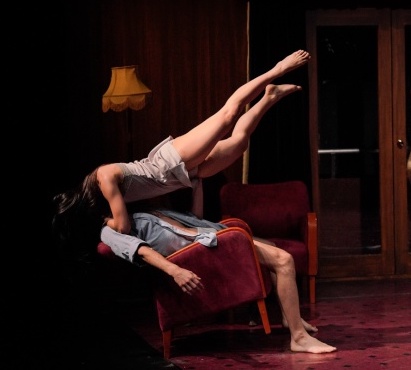Diptych: The missing door & The lost room
Kiri Te Kanawa Theatre - Aotea Centre, Auckland
22/03/2024 - 24/03/2024
Auckland Arts Festival | Te Ahurei Toi o Tāmaki 2024
Production Details
created by Gabriela Carrizo and Franck Chartier
Peeping Tom
Peeping Tom
In Aotearoa for the very first time, Belgium’s Olivier Award-winning Peeping Tom brings two mind-blowing stories of mystery, horror, illusion and noir to the stage.
In an enigmatic labyrinth of missing doors and lost rooms, various characters wander in a trance between fiction and reality. Memories, desires, dreams and nightmares flash before their eyes. Will they or won’t they escape?
The creative minds behind the world’s “freakiest theatre troupe” (The Guardian) have crafted an intensely atmospheric, wildly suspenseful thriller that will pull you in and refuse to let go. Boldly cinematic, Diptych is also a masterclass in set, lighting and sound design, and a world-class showcase for the physical prowess of its performers, who move and dance acrobatically like pawns at the hands of unknown forces.
Concept and direction
Gabriela Carrizo and Franck Chartier
Performance
Konan Dayot, Fons Dhossche, Lauren Langlois, Panos Malactos, Alejandro Moya, Fanny Sage, Eliana Stragapede, Wan-Lun Yu
Artistic assistance
Thomas Michaux
Sound Dramaturgy
Raphaëlle Latini
Sound composition and arrangements
Raphaëlle Latini, Ismaël Colombani, Annalena Fröhlich, Louis-Clément Da Costa, Eurudike De Beul
Light design
Tom Visser
Set design
Gabriela Carrizo, Justine Bougerol
Costume design
Seoljin Kim, Yi-chun Liu, Louis-Clément Da Costa
Confection costumes
Sara van Meer, Lulu Tikovsky, Wu Bingyan (intern)
Technical coordination
Giuliana Rienzi, Pjotr Eijckenboom (creation)
Technicians
Bram Geldhof/Ilias Johri (lights), Tim Thielemans/Jonas Castelijns (sound)
Stage management
Thomas Dobruszkes (stage manager), Clement Michaux (stage assistant)
Production intern
Lisa Gunstone, Robin Appels
Dance , Dance-theatre , Physical , Contemporary dance ,
90 mins
Macabre humor and suspenseful anticipation
Review by Teianna Chenkovich 23rd Mar 2024
A Diptych is traditionally a piece of visual art made up of two halves, it often serves as an altarpiece with two wooden panels connected by a hinge that may be closed and opened like a book. Diptych: The missing door & The lost room is a reimagining of a Diptych as dance theatre. On one panel is The missing door originally created by Gabriela Carrizo in 2013, and the other is The lost room created in 2015 by Franck Chartier. The lost room (2015) follows the creation of The missing door (2013) and intentionally carries through the themes and ideas the forerunner presents.
Peeping Tom, Carrizo & Chartier’s Belgian based dance-theatre company, brings these two halves together into one beautifully bizarre dreamscape of a production. They create two spaces, one a hallway or transient place of doors that refuse opening, and the other a room on a ship that is both transient and confining. There is no intermission when they change out the set, the dancers move amongst the tech crew, sometimes aiding in the transition and sometimes hindering its progress. This is the hinge of the Diptych, visible and necessary to join the two works together. Then finally, the scene is set, and the Maid is left to primp and preen the space.
The dutiful and active Maid is the undercurrent pinning each narrative to a recognizable figure. She provides a rhythm to the works as she tidies, resets set pieces, and is utilized by the characters to progress the narrative. She is part of the set, a separate entity from the characters yet entangled in their unfolding dramas. She grounds the nonlinear and fractal story across place and time.
This is a story from a broken and distorted memory, a thing unfixed and pliable. In The missing door music plays like a broken record getting caught on a scratch, as dancers’ flick through the same motions again and again, also caught on the scratch. Repetition, distortion, reversal, transmutation are the choreographic structures of choice as ideas revisit and reprise continuously with renewed intrigue. A duet where the wild and unruly man hoists his partner like a rag doll, her body passive and pliant, is echoed later in a sensual duet where her now active and agential body maneuvers in coordination with her male partner.
The gender roles of women and men are a commentary and device to create a slightly sinister and antique atmosphere. The male-identifying characters demonstrate their agency and choice, manipulating, moving, restraining, defining the bodies of their female counterparts. In one scene a crazed woman attempts to escape while being restrained and confined by her male counterparts. We get a look into her distorted perception as she opens each door to reveal they have all become closets. The women of Diptych are passive, crazy, lustful, supporting characters, all typecast roles women traditionally have played in media. The maid for instance, cowering on the ground as a maniac of a man rips through the stage and harasses her. This is not a careless byproduct of biased storytelling but a conscious choice to create a certain melancholy and sepia-toned aesthetic.
What makes Diptych: The missing door & The lost room brilliant is its ability to surprise you with unexpected twists, magical special effects, and stunning dancers that make sense of the senseless. The performers carry the work with an effortlessness and ease that makes it all the more believable. Filled with a macabre humor and suspenseful anticipation the audience is immersed in a world that is both familiar and strange. My body leans forward in expectation, jumps in surprise, and withers in embarrassment all while sitting in my seat.
Copyright © in the review belongs to the reviewer







Comments